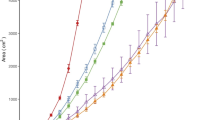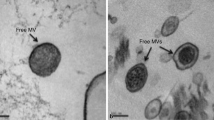Summary
Transfer of a non-Mendelian neamine-dependent (nd) mutant to an antibioticfree medium results in neamine-sensitive and neamine-resistent revertants. These reversions are caused by extranuclear mutations.
The neamine-sensitive revertants are no more able to split offnd-cells after back-donation to neamine containing medium. Therefore they are different from the streptomycin-sensitive revertants of a streptomycin-dependent (sd) mutant. These mutants were capable ofsd-segregation though their potence ofsd-segregation diminished on antibiotic-free medium with increasing time of cultivation.
The different behaviour can be explained by the fact that manysd-genes are present which have to be appointed to the mitochondria. On the other side, thend-gene exists only in few copies and is located therefore in the chloroplast.
Several experiments with differing methods are discussed to localize the extranuclear genes.
Similar content being viewed by others
Literatur
Arnold, C. G., Schimmer, O.: Die Lokalisation extrakaryotischer Gene beiChlamydomonas reinhardii. Ber. dtsch. bot. Ges.83, 363–367 (1970).
—— Schötz, F., Bathelt, H.: Die Mitochondrien vonChlamydomonas reinharddii. Arch. Mikrobiol.81, 50–67 (1972).
Bastia, D., Chiang, K. S., Swift, H., Siersma, P.: Heterogeneity, complexity, and repetition of the chloroplast DNA ofChlamydomonas reinhardtii. Proc. nat. Acad. Sci. (Wash.)68, 1157–1161 (1971).
Chiang, K. S.: Replication, transmission and recombination of cytoplasmic DNAs inChlamydomonas reinhardtii, p. 235–249. In: Autonomy and biogenesis of mitochondria and chloroplasts, ed. N. V. Boardman, A. W. Linnane, R. Smillie. Amsterdam-London: North Holland Comp. 1971.
Ettl, H.: Relation of mitochondria to the kinetie apparatus in the genusChlamydomonas, p. 38–42. In: An. Rep. Labor Algol. 1969, ed. Czechoslov. Acad. Sci., Inst. of Microbiol., Trebon (1970).
—Chlamydomonas als geeigneter Modellorganismus für vergleichende cytomorphologische Untersuchungen. Arch. Hydrobiol. Suppl. 39. Algol. Stud.5, 259–300 (1971).
Gillham, N. W.: Induction of chromosomal and nonchromosomal mutations inChlamydomonas reinhardi with N-methyl-N′-nitro-N-nitrosoguanidine. Genetics52, 529–537 (1965).
Ris, H., Plaut, W.: Ultrastructure of DNA containing areas in the chloroplast ofChlamydomonas. J. Cell Biol.13, 383–391 (1962).
Sager, R.: Genetic studies of chloroplast DNA inChlamydomonas, p. 401–418. In: Symp. Soc. Exp. Biol. 24, Control of organelle development, ed. P. L. Miller. Cambridge: At the Univ. Press 1970.
— Ramanis, Z.: Biparental inheritance of nonchromosomal genes induced by ultraviolet irradiation. Proc. nat. Acad. Sci. (Wash.)58, 931–937 (1967).
——: The pattern of segregation of cytoplasmic genes inChlamydomonas. Proc. nat. Acad. Sci. (Wash.)61, 324–331 (1968).
——: A genetic map of non-mendelian genes inChlamydomonas. Proc. nat. Acad. Sci. (Wash.)65, 593–600 (1970).
——: Methods of genetic analysis of chloroplast DNA inChlamydomonas, 250–259. In: Autonomy and biogenesis of mitochondria and chloroplasts, ed. N. K. Boardman, A. W. Linnane, R. M. Smillie. Amsterdam-London: North Holland Comp. 1971.
Schimmer, O., Arnold, C. G.: Untersuchungen über Reversions- und Segregationsverhalten eines außerkaryotischen Gens vonChlamydomonas reinhardii zur Bestimmung des Erbträgers. Molec. gen. Genet.107, 281–290 (1970a).
——: Über die Zahl der Kopien eines außerkaryotischen Gens beiChlamydomonas reinhardii. Molec. gen. Genet.107, 366–371 (1970b).
——: Hin-und Rücksegregation eines außerkaryotischen Gens beiChlamydomonas reinhardii. Molec. gen. Genet.108, 33–40 (1970c).
——: Die Suppression der außerkaryotisch bedingten Streptomycin-Abhängigkeit beiChlamydomonas reinhardii. Arch. Mikrobiol.73, 195–200 (1970d).
Schötz, F.: Dreidimensionale, maßstabgetreue Rekonstrucktion einer grünen Flagellatenzelle nach Elektronenmikroskopie von Feinschnitten. Planta (Berl.)102, 152–159 (1972).
Schötz, F. Arnold, C. G., Schimmer, O.: Die Organisation derChlamydomonas-Zelle. Eine dreidimensionale Rekonstruktion nach der Elektronenmikroskopie von Serienschnitten. Cytobiol. (im Druck).
Surzycki, S. J.: Genetic functions of the chloroplast ofChlamydomonas reinhardi: Effect of rifampicin on chloroplast DNA-dependent RNA-Polymerase. Proc. nat. Acad. Sci. (Wash.)63, 1327–1334 (1969).
— Gillham, N. W.: Organelle mutations and their expression inChlamydomonas reinhardi. Proc. nat. Acad. Sci. (Wash.)68, 1301–1306 (1971).
Wells, R., Sager, R.: Denaturation and renaturation kinetics of chloroplast DNA fromChlamydomonas reinhardi. J. molec. Biol.58, 611–622 (1971).
Author information
Authors and Affiliations
Additional information
Vorgelegt durch G. Melchers
Rights and permissions
About this article
Cite this article
Behn, W., Arnold, C.G. Zur Lokalisation eines nichtmendelnden Gens vonChlamydomonas reinhardii . Molec. Gen. Genet. 114, 266–272 (1972). https://doi.org/10.1007/BF01788896
Received:
Issue Date:
DOI: https://doi.org/10.1007/BF01788896




